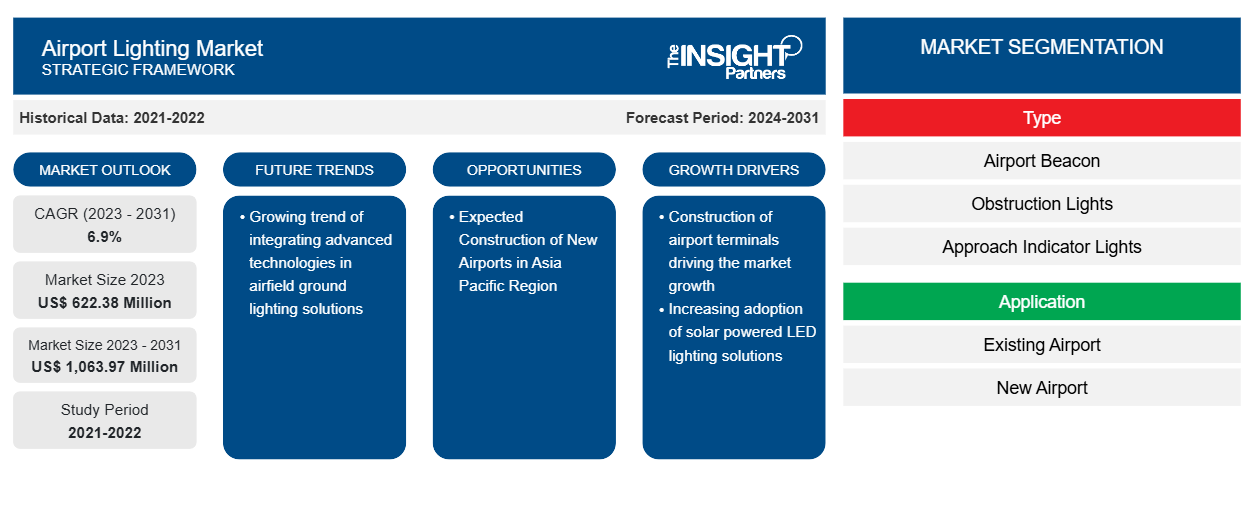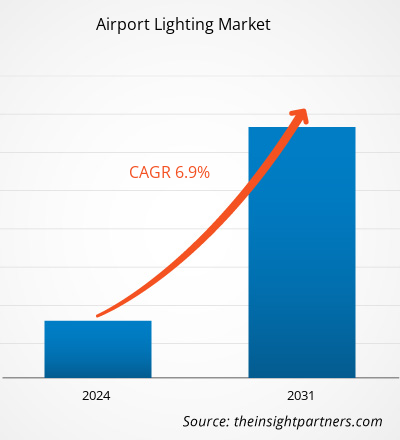The airport lighting market size is projected to reach US$ 1,063.97 million by 2031 from US$ 622.38 million in 2023. The market is expected to register a CAGR of 6.9% during 2023–2031. Growing trend of integrating advanced technologies in airfield ground lighting solutions is likely to remain a key trend in the market.
Airport Lighting Market Analysis
The airport lighting manufacturers source various components from different component manufacturers and integrate the same on their products. Competition among the airport lighting manufactures is always high, owing to the increased demand for such technology. Also, the specifications of these lighting solutions are defined by certification, namely FAA and ICAO. The manufacturer or supplier has to compete with its peers based on price, time lead, and aftersales services, which as a result increases the competition in the market. The product manufacturers sell their products either through direct sales channel or through offline distributors. The airport lights are also sourced through online channels, which further intensifies the competition among the players. Some of the major airport lighting manufacturers include; ADB Safegate, Astronics Corporation, Carmanah Technologies, Honeywell International Inc., OSRAM GmbH, and OCEM Airfield Technology, among others. The airport lighting market is fragmented, and several players are operating in the market, thereby, contributing substantial revenues year on year.
Airport Lighting Market Overview
The supply chain analysis on airport lighting market analyses the contribution of player operating in the ecosystem such as raw material or component manufacturers, OEM, system integrators, sales channel and end users. The airport lights comprise of several components including LED chips cables, cordsets, lamp holders, holder adapters, lamp suspensions, and metallic components, among others. The component manufacturers work in synchronization with the original equipment manufacturers which further supply their products directly to the end user through multiple sales channel or supply it to the system integrator which design the required system and then integrate it at the airport. To cater to rapidly changing needs for airport lighting solutions, these component manufacturers invest significant amounts in designing and developing robust gears. Because of the significance of each component, the end users and certification authorities are emphasizing heavily on specifying the measurements. Some of the airport lighting component manufacturers worldwide include Cree Inc., AVS Lighting Components, and Inlico, among others. Various other component manufacturers are also operating in the market and are facilitating the airport lighting manufacturers to cater to the growing need for such lighting solutions to respective clientele.
Customize This Report To Suit Your Requirement
You will get customization on any report - free of charge - including parts of this report, or country-level analysis, Excel Data pack, as well as avail great offers and discounts for start-ups & universities
Airport Lighting Market: Strategic Insights

-
Get Top Key Market Trends of this report.This FREE sample will include data analysis, ranging from market trends to estimates and forecasts.
Airport Lighting Market Drivers and Opportunities
Construction of Airport Terminals Driving the Market Growth
Several airport terminal construction projects have been completed and announced in 2023 that has driven the market for installation of airport lightings. Moreover, the upcoming plans for the construction of new airport terminals is likely to drive the market in the coming years. For instance:
- In January 2023, Newark Liberty International Airport (EWR) commenced passenger operations at its new Terminal A.
- In February 2023, Kansas City International Airport (USA) announced the opening of its new single terminal that replaced its three previously operational terminals.
- In March 2023, Auckland Airport (NZL) announced to invest US$ 3.9 billion in its terminal integration programme.
- In April 2023, Chennai International Airport (IND) announced the opening of its new terminal that spans 136,295 sq metres and increased the airports’ capacity 23 million to 30 million passengers annually.
Such factors have been pushing the demand for airport lighting for terminal applications.
Expected Construction of New Airports in Asia Pacific Region
The rise in new construction projects is one of the major factors likely to provide new opportunities for markt vendors in the coming years. For instance, in 2018, the Civil Aviation Administration of China (CAAC) announced to construct 216 new airport in the country by the end of 2035. Similarly, the Indian government has also announced the investments worth US$ 12 billion for the construction of 72 new airports by the end of 2025. Such factors are likely to generate new demand for airport lighting solutions across the Asia Pacific region and will provide new opportunities for market vendors in the coming years.
Airport Lighting Market Report Segmentation Analysis
Key segments that contributed to the derivation of the airport lighting market analysis are type and application.
- Based on type, the airport lighting market is segmented into airport beacon, obstruction lights, approach indicator lights, runway centerline lights, taxiway lights, and others. The approach indicator lights segment held a larger market share in 2023.
- Based on application, the airport lighting market is segmented into existing airport and new airport. The existing airport segment held a larger market share in 2023.
Airport Lighting Market Share Analysis by Geography
The geographic scope of the airport lighting market report is mainly divided into five regions: North America, Europe, Asia Pacific, Middle East & Africa, and South America.
Asia Pacific has dominated the market in 2023 followed by Europe and North America regions. Further, Asia Pacific is also likely to witness highest CAGR in the coming years. This is mainly due to the presence of large number of new airport construction projects across the countries of APAC region in the coming years. For instance, India and China have already announced to construct more than 285 airport by the end of 2035 which is further expected to drive the demand for airport lighting solutions in the region.
Airport Lighting Market Regional Insights
The regional trends and factors influencing the Airport Lighting Market throughout the forecast period have been thoroughly explained by the analysts at The Insight Partners. This section also discusses Airport Lighting Market segments and geography across North America, Europe, Asia Pacific, Middle East and Africa, and South and Central America.
Airport Lighting Market Report Scope
| Report Attribute | Details |
|---|---|
| Market size in 2023 | US$ 622.38 Million |
| Market Size by 2031 | US$ 1,063.97 Million |
| Global CAGR (2023 - 2031) | 6.9% |
| Historical Data | 2021-2022 |
| Forecast period | 2024-2031 |
| Segments Covered |
By Type
|
| Regions and Countries Covered |
North America
|
| Market leaders and key company profiles |
|
Airport Lighting Market Players Density: Understanding Its Impact on Business Dynamics
The Airport Lighting Market is growing rapidly, driven by increasing end-user demand due to factors such as evolving consumer preferences, technological advancements, and greater awareness of the product's benefits. As demand rises, businesses are expanding their offerings, innovating to meet consumer needs, and capitalizing on emerging trends, which further fuels market growth.

- Get the Airport Lighting Market top key players overview
Airport Lighting Market News and Recent Developments
The airport lighting market is evaluated by gathering qualitative and quantitative data post primary and secondary research, which includes important corporate publications, association data, and databases. A few of the developments in the airport lighting market are listed below:
- Honeywell (NASDAQ: HON) today announced the launch of its Airfield Ground Lighting (AGL) manufacturing facility in Gurugram, India. AGL is a Make in India product engineered and manufactured completely in India. AGL plays a crucial role in airport operations and is subject to comprehensive safety and compliance regulations by global aviation standards and regulatory bodies. (Source: Honeywell International inc, Press Release, Aug 2023)
ADB SAFEGATE is excited to announce the launch of its new AXON EQ fixtures, a range of intelligent LED inset lights that have built-in sensors to collect situational data. The AXON EQ lights are equipped with integrated LINC 360 remotes, essential for creating two-way communication that allows for more streamlined, predictive airport operations. (Source: ADB SAFEGATE, Press Release, May 2022)
Airport Lighting Market Report Coverage and Deliverables
The “Airport Lighting Market Size and Forecast (2021–2031)” report provides a detailed analysis of the market covering below areas:
- Airport lighting market size and forecast at global, regional, and country levels for all the key market segments covered under the scope
- Airport lighting market trends as well as market dynamics such as drivers, restraints, and key opportunities
- Detailed porter’s five forces analysis
- Airport lighting market analysis covering key market trends, global and regional framework, major players, regulations, and recent market developments
- Industry landscape and competition analysis covering market concentration, heat map analysis, prominent players, and recent developments for the airport lighting market
- Detailed company profiles
Frequently Asked Questions
Which region dominated the airport lighting market in 2023?
What are the driving factors impacting the airport lighting market?
What are the future trends of the airport lighting market?
Which are the leading players operating in the airport lighting market?
What would be the estimated value of the airport lighting market by 2031?
What is the expected CAGR of the airport lighting market?
- Historical Analysis (2 Years), Base Year, Forecast (7 Years) with CAGR
- PEST and SWOT Analysis
- Market Size Value / Volume - Global, Regional, Country
- Industry and Competitive Landscape
- Excel Dataset
Recent Reports
Testimonials
Reason to Buy
- Informed Decision-Making
- Understanding Market Dynamics
- Competitive Analysis
- Identifying Emerging Markets
- Customer Insights
- Market Forecasts
- Risk Mitigation
- Boosting Operational Efficiency
- Strategic Planning
- Investment Justification
- Tracking Industry Innovations
- Aligning with Regulatory Trends





















 Get Free Sample For
Get Free Sample For